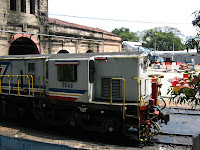 Train spotters in Malaysia should not miss the opportunity to experience the multimedia art exhibition titled - Iron Dragons of Malaya, and at the same time enjoy a nostalgic trip to the country’s largest railway shed – the KTMB workshop in Sentul.
Train spotters in Malaysia should not miss the opportunity to experience the multimedia art exhibition titled - Iron Dragons of Malaya, and at the same time enjoy a nostalgic trip to the country’s largest railway shed – the KTMB workshop in Sentul.The photography collection showcasing the depleting British-built shed and rolling stocks or whatever there is left were produced using state-of-the-art photography technique known as High Dynamic Range.


Visitors, according to K. Azril Ismail, the architect of the exhibition, will be rewarded with captivating 3-D like images. They will also be entertained by multimedia presentation which took Azril and his team a year to produ ce.
ce.
Such an effort is a befitting tribute to the train workshop as it spends its last remaining days at Sentul.
Sentul workshop first took its form in1905 but by the year end, the entire KTM overhaul job will be moved to Batu Gajah. The entire area is then set to undergo a massive property development and discards any association it has with the railway legacy.
Hence, Azril’s exhibition is not just timely but akin to an obituary for a century of faithful services rendered.
The Iron Dragons of Malaya – is currently run at KLPac till Jan 25, 09, and admission is free.
 ce.
ce.Such an effort is a befitting tribute to the train workshop as it spends its last remaining days at Sentul.
Sentul workshop first took its form in1905 but by the year end, the entire KTM overhaul job will be moved to Batu Gajah. The entire area is then set to undergo a massive property development and discards any association it has with the railway legacy.
Hence, Azril’s exhibition is not just timely but akin to an obituary for a century of faithful services rendered.
The Iron Dragons of Malaya – is currently run at KLPac till Jan 25, 09, and admission is free.



